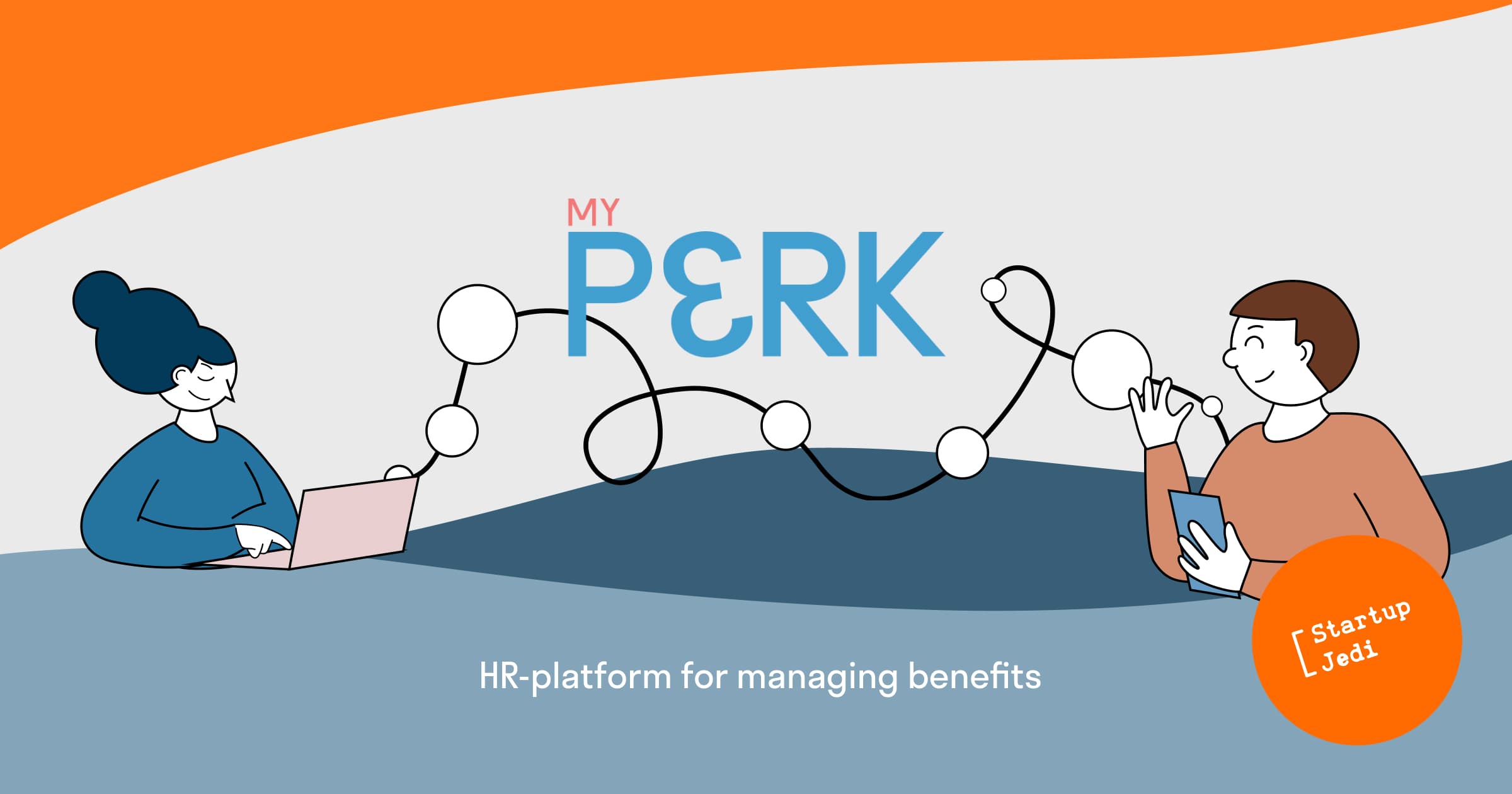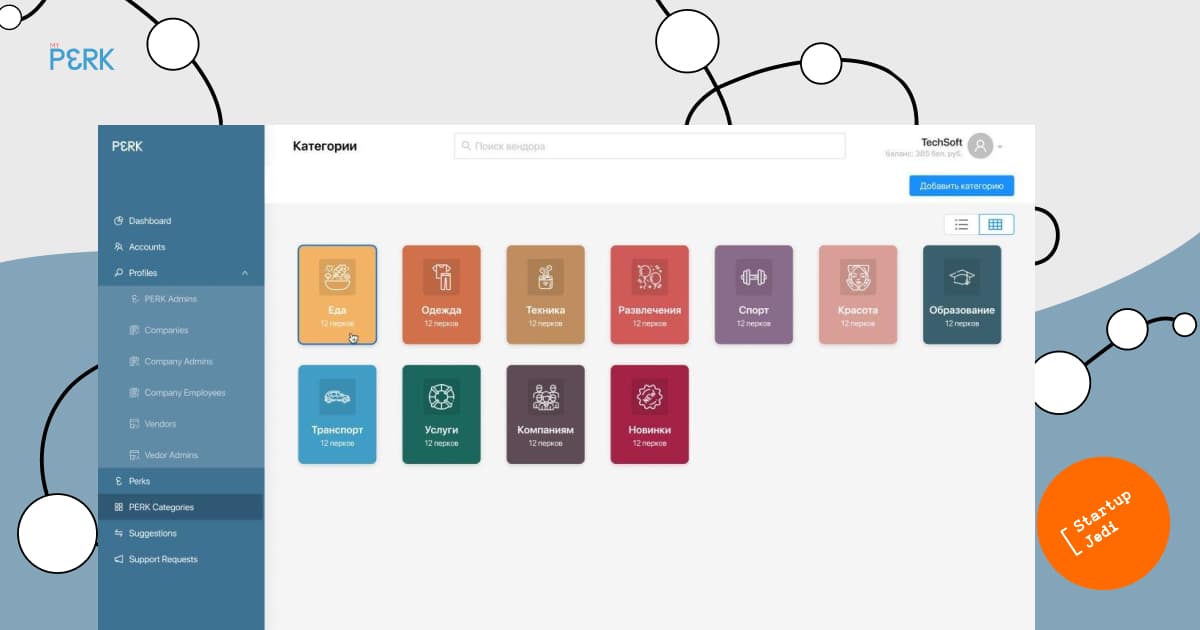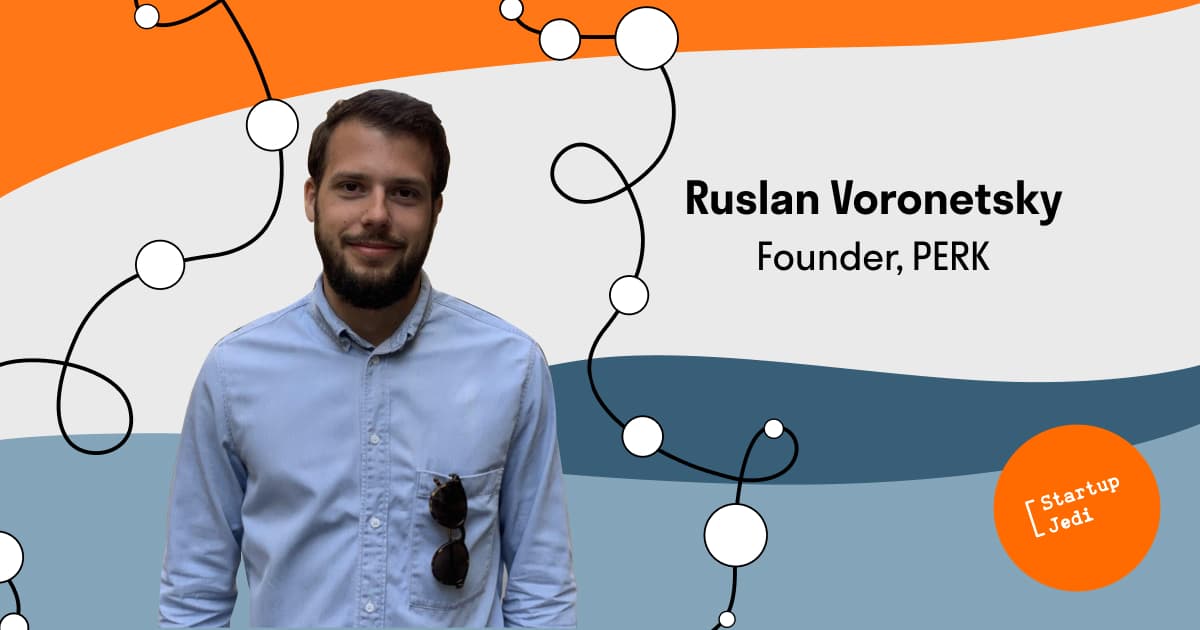
Startup Jedi
We talk to startups and investors, you get the value.
Both large and small serious IT-companies care to have professionals in their teams. In order to keep such professionals, each company masterminds a program of benefits - a list of things that employees can get or achieve despite the salary or bonuses. Different companies have different packages: some limit themselves with coffee and cookies, others have a pretty long list. PERK startup develops a universal platform for HRs, where they will be able to design a personalized bonus system for their employees.
Ruslan Voronetskiy, PERK founder, tells us how it works.

Startup Jedi
We talk to startups and investors, you get the value.
PERK (something that a person receives at work, except for salary) — an application for companies which use benefits and want to increase their effectiveness through personalized bonuses as well as to automate the process of using the social package.
With its help, each employee chooses those company’s benefits, which are of the most interest to him. In turn, HR can add new employees and vendor partners to the application regardless of their location. Using the service, you can also pay for purchases from partners directly and free the financial team from unnecessary work.
...

- How did the idea of a product hit you?
- The idea appeared as the result of my personal pain. Before all this, I was a COO in Appodeal. Our team was opening an office in Minsk and was also dealing with all supporting questions, including the social package development — the creation of the benefits’ program and its further management.
Benefits are everything that an employee receives apart his salary. Usually, these are medical services (insurance or upkeep in medical centres), workout compensations, loyalty programs (a list of locations, where the employee can get discounts, bonuses or presents), learning foreign languages, team buildings, paying for the fuel/transport, paying for lunches/cheque compensations, food in the office, financial assistance (birthdays, weddings, children birth), sick leave… There is a pretty great variety! The main task of the benefits is to retain employees, attract them and increase loyalty to the company.
While implementing the beneficial program in Appodeal we faced a great number of questions. The HR team tried to balance between two extremities — make everything as convenient as possible for employees and load the administrative team with unnecessary processes and expenses, or make everything in a way that the HR team does not know the problems and hassle at all, and the employees simply accept the rules and options “as they are”.
Compromises in such matters ultimately affect the performance of the benefits system as a tool in general.
Then I understood that it is possible to create a solution which will allow companies to use a ready-made product, stop reinventing the wheel and searching for the compromises creating the program of benefits.
Once, I was in the bar with friends from IT-companies, and one of my friends said that it would be great if an HR-team would make a deal with all bars on Zybitskaya about benefits. By the way, back then, he didn’t know that he would be CTO of the project. The morning after the party, I was hit by the idea of how to solve all the problems with one product.
Cooperation with Appodeal company has ended but the market problem left. So that’s how the idea to create our product appeared. I had this pain — and I knew it was not only my pain, so the pain had to be killed.
- What market problem do you solve?
- The main problem is that every HR tries to find the thing that will allow gratifying employees from the one side but from the other side will help to avoid operational hell for the business. It is evident that the more benefits you take the harder it is to service them: search, tender, conclude contracts, track the quality. And it is a major pain. It will intensify if you imagine, that you have a few offices around the world and a team that doesn’t only work full-time.
Often it happens that the offered benefits are irrelevant for some employees. For instance, if the company pays the insurance but the person never got to the hospital. So, the person seems to have a benefit but in fact, he doesn’t. The same with paid taxis when the employee has his own vehicle. Or when the company is ready to give a refund for the gym pass, however, it is not willing to pay for participation in conferences.
That’s the kind of problem we are dealing with for the business to be able to give its employees maximum opportunities and relevant benefits with minimum efforts.

- The service is designed both for HR’s and for employees: can you describe step-by-step what actions will be available for these two teams, after the company pays for the software?
- We were trying to make everything as easy as possible.
HR-manager gets access to the company’s account, where we have anticipatorily uploaded all accounts of the employees and partners from the corporate loyalty program.
Once a new person is employed, the HR-manager easily makes an account in the database for him. The same goes to the loyalty program partners: it is extremely simple to add their profile manually, directly in the company’s cabinet, approach us in case any help is needed, for example, if a specific integration is needed or to choose an existing offer from our partners. Every week we increase the number of our partners, starting from transport (anytime, Eleven), fashion (LaModa) and ending with educational courses (BeVisual, SPACE), interior design services (Nota Bene) and landscaping (Rosemary).
After that, the HR sets the rules regarding the usage of the benefits for employees (price, vendor categories) and makes a so-called “basket”, composed of various benefits. As soon as the HR-manager forms his offer, the employees receive a notification and can start to customise it according to their needs.
Via his mobile application, the employee can use the corporate loyalty program, as well as benefits collected specifically for him and paid by the company, by showing his QR or promo-code to the partner. To do so, the employee should request “to pay” command and conduct the payment as he is used to doing with all the other purchases: with a credit card, phone, or by entering payment details on a website. The platform validates the operation and then the payment is transferred in favour of the vendor. The whole history of benefits’ usage is saved in the HR’s account in the form of analytics per each employee and for the company in general.
...

- How much time did it take from the idea to the project realization?
- The idea itself, as a problem hypothesis and ways of its solution, came to my mind in June, and in August-September, the idea received some product description and first specification. The team started to realize the product in October 2019. At the beginning of this March, we launched the first version of the app in AppStore and GooglePlay.
- What has already been done?
- The first version of our application is already available in mobile stores. In order to use it, you have to fill the application form on perk-card.com. Also, we have the product’s web-version ready. Currently, we are at the stage of integration with bank API to start making payments. There are left bank card emission and processing integration out of the things we have planned.
- How many investments do you need to complete the project?
- We will never finish the project and that’s why it’s a lot of money;) In fact, we will constantly improve and develop by receiving feedback from users. Up until now, the product was developing at its sole cost and expense. But if we are talking about a short-term perspective, we are planning to finish the integration with partner banks, solidify in Belarus and Russia, and also, prepare the product to be launched in the European market. We need another $50 000–60 000 of investment to complete this goal in the nearest times.
Now, we are at the stage when we are communicating with investors. We also communicate with business angels. We look at their experience and possibilities, try to organise a win-win situation for both parties. Anyway, we want to work using a smart-money principle. And to be honest, we don’t need any other work-format.
...

- Did you get feedback from the real users? How did they evaluate the application and its work?
- Sure as we have a beta-version. At first, on our platform, we launched features that allow creating corporate loyalty programs. Companies can use both existing partner applications and connect our partner’s ones.
We launched the application on AppStore on March 3rd, and on Google Play we appeared even a bit earlier. In 3–4 days, starting from the moment of launch, we received application forms from 29 companies with a total count of 2500 employees. In a week, the story with COVID-19 and remote work started, so the majority of companies set the onboarding process on pause.
From those who managed to use the application, we received positive feedback and a number of comments, which, by the way, we have already taken into account, and we will roll out a new version as soon as the situation with the pandemic changes.
Recently we have opened free access for everyone in StayHomePERK mode. To use it, you have to click “Download” on perkcard.by website and indicate your mail. You will receive an invitation for registration in response and after that, all perks, that are relevant in lockdown mode, will become available.
Several times we received investment proposals from the heads and owners of companies during the installation and demonstration of functionality, but there is still work to do. In general, what I say to all our users is: say what’s bad. And let’s omit what’s good.
- Where do you get clients?
- We know right well the CIS market, it is facilitated by the experience and reputation of the founders, so you do not have to look for customers. We know who has the pains and we go there with our solution. And taking into account the marketing buzz, we do not yet include paid channels of attraction.
Our clients are companies with 25+ employees. Also, there are non-IT companies among the companies with which we are in the stage of discussing the conditions but these are rather exceptions.
- Do you have real clients?
- For me, a real client is a client that has already paid for the product in money. Unfortunately, currently, we don’t have such clients, again due to the virus, the signing of contracts has been postponed.
We have quite a lot of companies paying us in terms of their time and other resources (discussing contracts, involving teams to test the product, take part in calls to provide feedback), thus, we are waiting for the situation to change so we will be able to help businesses to solve the tasks with our product.
- What are the project’s revenue sources?
- We are using a subscription model. Companies are paying for each employee account connected to the system. Depending on the duration of the subscription and the number of employees the price may vary from $3 to $8 a month per user. $8 means that the company has all app’s features and an opportunity to customise the application in corporate colours.
- How do you plan to promote the product?
- The client-involvement price should be as low as possible, and we are on a stage when it actually should be aiming to zero, therefore, a short-term promotion strategy includes the promotion through the HR community, participation and organisation of various conferences, creating special projects that will attract the attention to our project and, of course, social networks and LinkedIn, via, roughly speaking, creating the content.
...

- Correct it me I’m wrong, you are launching a project for Russian-speaking clients?
- Let’s put it like this, the project is almost ready to be launched for Russian-speaking clients, however, it is more of a short-term strategy for us that aligns with the promotion, I have mentioned beforehand. Our company aims to become a global provider of such HR solutions.
- Why did you decide to launch in our region?
- Due to various reasons: a great number of companies competing for the employees in different ways; amazing relationships with the needed communities in the region that allowed us to receive feedback very fast; a great understanding of legislation (taxing, labour and banking), which in such products plays a significant role; good market knowledge that allows us to create a great funnel from the business perspective.
Besides the positive aspects in a short-term perspective, we have an understanding that the trend for remote work will lead to the situation when the company will be able to employ workers from any place in the world. And where are the best specialists in terms of price/quality? Right, in CIS. So, how is it possible to provide them with the same benefits that guys from the main headquarters in the US have? This is the time when you should look into the PERKS products in a particular region.
- Who are your main competitors?
- They are, as well as we are, young companies launched in 2019 and are on seed-stage. They are Mistrom, Zestful, Getbenepass, Cobee.
I like the idea of where we are all moving, we have this sporting interest, bearing in mind that we all started to run at almost the same time.
Our benefit is that the business receives discounts for benefits from our partners, so they get not only indirect but also direct savings, and the employees get smart recommendations on what is more beneficial to use.
- What companies/projects experiences did you learn before launching your startup??
- Those all are the companies and projects I was involved in. I worked in a consulting and IT product company. It is also experience and stories that I encounter at various conferences, Telegram-channels, in books, etc. I am trying to read a lot and communicate with those who have been in my shoes.
...

- How did you search for the team?
Somehow, the team managed to complete it on its own. Product designer is my friend that believed in the idea and started working with me from the very beginning. By the start of the developing process, my own brother has acquired great expertise in the fintech field. Project CTO joined us by the recommendation, and the developers team consists of his ex groupmates. Halyna, the CPO, worked with me in Appodeal.

- Which specialists were the most difficult to find for the project?
- The most difficult was to find developers, which did not come by as a surprise. There is a great competition on the market, with a lot of new companies with dominant names. Obviously, not everyone will take a risk to come to the market on the stage of searching for “problem-solution fit”; thus, to find this team was the most complicated thing. I am, however, delighted with the result.
- Was it difficult to work together?
- Our relationship with Halia, the product’s CPO, is more family-like. Our history started when we were spending 24/7 together. Once one of my friends — a project designer — joined us, it was the same history when everyone knows each other well.
With the CTO however, we basically did not know each other before starting to work on the common project. When he came to our office to work, it was our 4th meeting with him. The same happened when he invited developers to work on the project.
The greatest trouble was with the developing team, we barely knew each other yesterday and then you are working together 24/7 hand in hand. Moreover, all of the communication was revolving around work processes, thus, it turned out that you were almost living with this in the team in the office, however, you were barely acquainted with each other. Some kind of a reality-show. This experience can be compared to first-year students that see their classmates for the first time. Only after a few months we got used to each other and now are very close.
Facebook: facebook.com/StartupJedi/
Telegram: t.me/Startup_Jedi
Twitter: twitter.com/startup_jedi
Comments